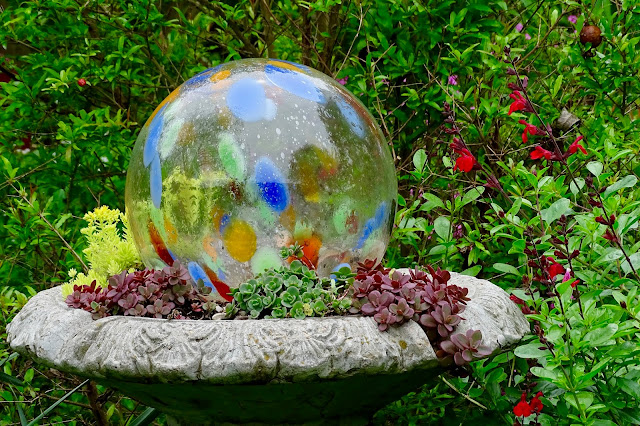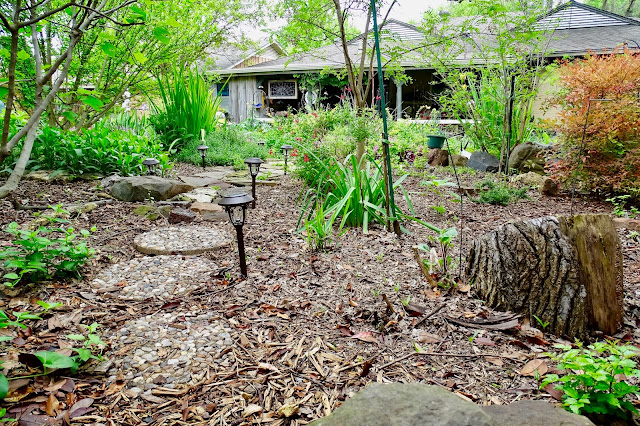If you were asked to list 10 things about Texas would one of them be.....It's so Hot?
And because of that, shade can be a most glorious thing during our long, sometimes brutal summers. And if you love to garden, having it around is a bonus, as is a large glass of iced tea....and ice cream....and cold watermelon.....and, oh sorry, I got a little distracted.
We have several contributors to the shadefest in our backyard. A 50+ year old Pecan tree planted by my parents in the late 60's. We did have some very old Hackberry trees along our back fence but lost them to some straighline 90 mile an hour winds, some icy weather and old age. We've replace them with a Fig tree, Mexican Plum, Eve's Necklace, Rose of Sharon and Sweet Almond Verbena. We also have a huge 20-30 foot Ligustrum that we should remove because it is very invasive, but it's evergreen and blocks some ugly views and we haven't been able to bring ourselves to do that yet. It also is a favorite of the Cedar waxwings when the berries are ripe.....and that is one of the reasons for its aggressive spread. But oh my......Aren't they lovely birds!
Our front yard has a grouping of 3 large Live Oak trees (also planted by my parents in the 60's). We have removed all grass from the backyard and have a little tiny swatch of grass in the front. In place of grass we have made pathways and garden beds.
Our list of goals for this has been growing. We want a beautiful, peaceful haven for ourselves and friends, we want to provide a safe wildlife habitat for local wildlife, we'd like to have as many native Texas plants as possible and provide nectar and pollen for as many pollinators as possible and we'd like to share what we have learned with others.
So on that note I would like to share some of my favorite plants that have grown successfully in the shade and with minimal care. I will just introduce a few and have a list of others that have done well and if there is any interest I can give more information about them.
On the top of the most hardy list.....
Turk's cap (malvaviscus arboreus var. drummondii).
This plant has a lot going for it! It is a favorite of the hummingbirds. Mine doesn't start blooming till mid to late June, but I've seen others start earlier. It can grow in full sun or shade. It is smaller in shade and taller in sun. You can find it in red, white or pink, though the hummers seem to like red the best. It spreads well but is manageable, and shareable. It grows from 2-3 feet and can get up to 9 feet, but can be trimmed back to any appropriate size. It is drought tolerant. In our zone 8a (Dallas, Texas) it dies back in the winter and sprouts out late spring. The fruit is edible. And....it is native to this area. And also, it is very long lived...it was planted by my parents probably in the 70's or 80's. What's not to love!
This is the pink one. Pretty cute, huh?
The next two native plants are fairly new to our yard but have very good reputations....
Heartleaf Skullcap (scutellaria ovata)
This little native beauty is in the mint family. It grows 1-2 feet tall. It colonizes underground and spreads that way and by seed. It can be aggressive but is easy to pull up (though some people think it's not). It blooms in early spring and is great for the bees! It dies back in the heat but is an evergreen groundcover in the winter.
Lyreleaf sage (salvia lyrata)
This little native perennial is also a member of the mint family. I found it to be very happy if I just left it alone. It easily reseeds, but is not aggressive. It is a very attractive evergreen with ajuga-like foliage and gets 1-2 feet tall. It blooms for 4-5 weeks in the spring and can be mowed and walked on. It grows in the sun, part sun and shade. And....it's edible!
I've always had a major crush on the next one. It's another native that I found did much better if I just ignored it. Johnny and I went hiking at the Rowlett Creek Preserve and found it growing profusely in the forest.
Pigeonberry (rivina humilis)
This beauty is a perennial herb about 1 foot tall that grows beneath trees and shrubs. The flowers are white to pink. The berries are numerous, red and almost translucent, often appearing on the lower part of the stem while the upper part is still blooming. They are a favorite food for many kinds of birds.
My last one to share with you is another tried and true in our garden.
Chili Pequin (Capsicum annuum)
The Chile pequin is a perennial native
hot pepper that is well behaved. It is very easy to grow
and the birds supposedly love it, but I've never seen them on mine. It will grow
with sun or shade. The fruits are edilble and are pretty hot. It's beautiful
when used in mass plantings. It blooms small white flowers that becomes fruit in late fall.
Some of my other favorites...some are natives, some are not.
Inland Sea Oats (chasmanthium latifolium) Native

Datura wrightii Native

Frostweed (verbesina virginica) Native

Garlic Chives

Golden Groundsel (packera obovata) Native

Horseherb/straggler daisy (calyptocarpus vialis) Native

Oxalis (articulata)

Texas Betony (stachy's coccinea)

Rock Rose (pavonia lasiopetala) Native

Gregg's mistflower (conoclinium greggii) Native

Dwarf Mexican Ruellia (Ruellia brittoniana)























































